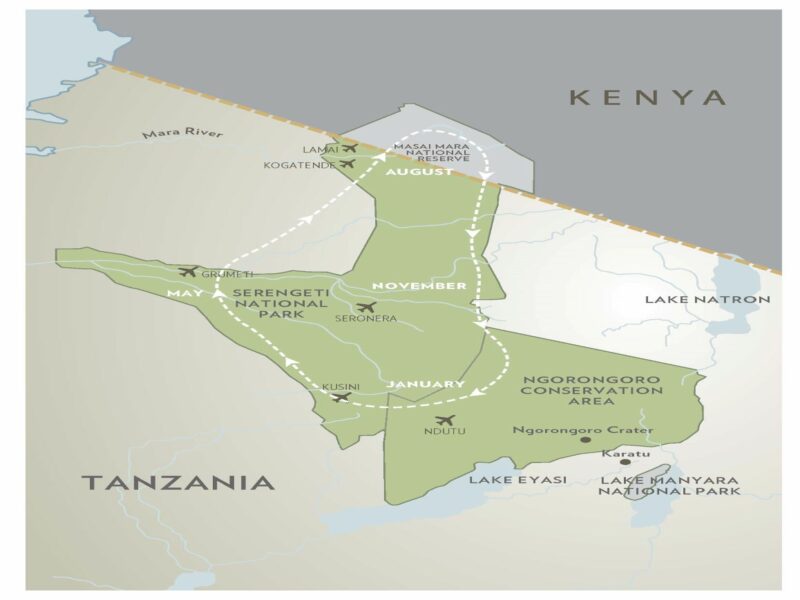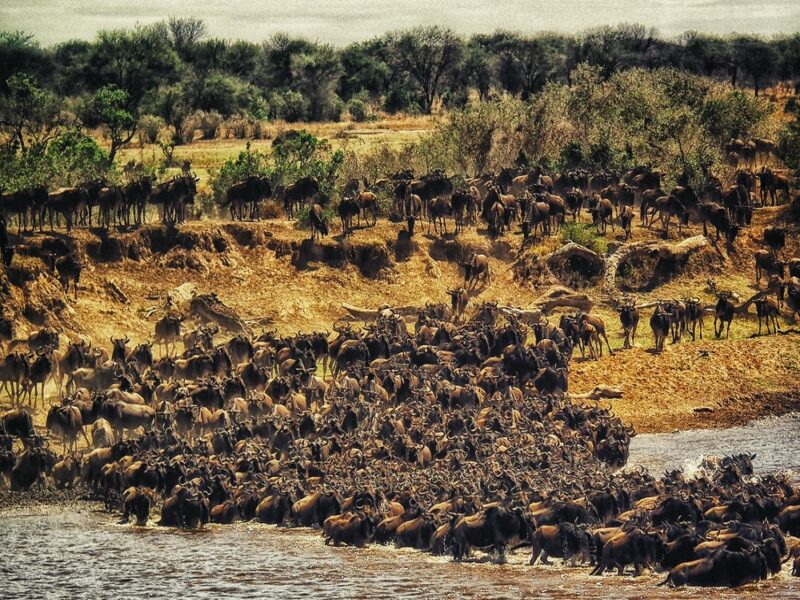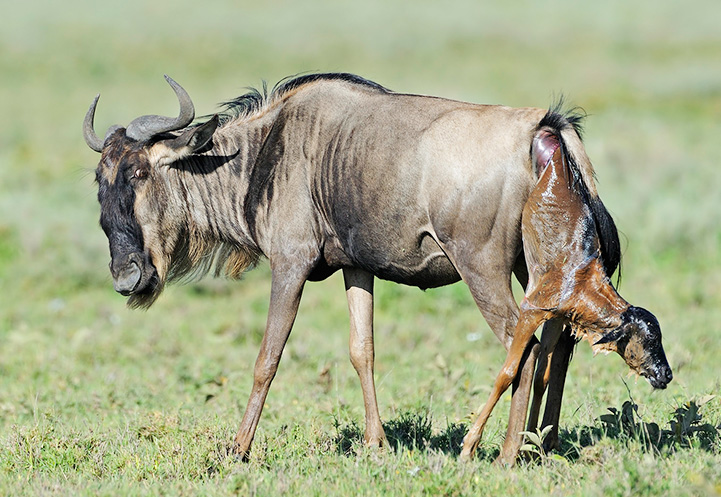The Great Migration of wildebeest is one of the wonders of the natural world, where millions of hooves drum against Africa’s plains – a journey fraught with danger and peril, and one that is on the bucket list of many a traveller.
So what exactly is this Great Migration and where can one catch this phenomenon?
It is the largest herd movement of animals on the planet. It is a circular migration of over 2 million animals (mainly wildebeest but also zebra and gazelle), across the Serengeti-Mara ecosystem in search of grazing and water. They follow an age old route from the Serengeti National Park in Tanzania, to the Maasai Mara Game in Kenya, and back again. With upto 1,000 animals per sq km, the wildebeest columns can be seen from space. Although the migration timing is different every year, depending on the rainfall and other factors, they follow the same route so it is possible to predict where and when you can find the densest concentration of game.
 MAP COURTESY OF ASILIA AFRICA
MAP COURTESY OF ASILIA AFRICA
The migration begins with the calving of the wildebeest in the southern Serengeti region, near the Ngorongoro Conservation, extending all the way to the Ndutu area. Hundreds of thousands of wildebeest give birth during this time, between late January and early February, but this can also start in December and go upto March. Literally thousands of calves are dropped daily, the large numbers compensating for calves eaten by predators on the prowl. Imagine seeing thousands of new born calves on an early morning game drive. This is high season in Tanzania so accommodation rates are quite high. If you are on a budget, you can skip this part and follow the herds on the next part of their journey.
Around April, the herds begin to drift northwest towards the Central Serengeti and fresh grass.
By May, the animals start congregating around the Moru Kopjes and you can see lines of wildebeest stretching for several miles. As this is the green season in Tanzania, it is a great time for budget travellers to catch the migration.
End of May brings with it the mating season and now you can see male wildebeest going head to head. The herds continue moving, trailed by zebra and gazelle, and in June, will begin to gather in the Western Corridor of the Serengeti, around the pools and channels of the Grumeti River. They have to cross the river in order to continue their onward journey, providing the crocodiles of the Grumeti River with a tasty feast. As this is still low season in Tanzania, it is a particularly good time to visit since tourist numbers are low and wildlife sightings spectacular.
Late June and heading into July, the herds continue along the western edge of the Serengeti, towards the Mara River, located in the Northern Serengeti. These river crossings are full of drama and action, as the Mara River crocs lie in waiting for the herds. This is now the beginning of the high season in Tanzania and Kenya, and bookings for accommodation here are made a year or even before in advance.
July finds the herds in the Northern Serengeti, as well as in the Maasai Mara in Kenya and daily river crossings can be seen on the Mara River, as well as the Talek River, both offering incredible wildlife action.

By August, the herds will have settled in the Mara, spreading through the northern areas of the Mara, with some herds still remaining in the Northern Serengeti. Where the river is in full flow, there is a lot of panic at the river crossings due to the strong currents and the presence of the predators waiting to pounce on the weak and tired. Some river crossings consist of a few individuals, while others host a mass of animals moving constantly for a few hours.
The wildlife viewing is at its most spectacular now, especially in the Mara, and accommodation prices are at their highest.
Towards October, the herds begin moving eastward, preparing for their return journey but they still have to cross the Mara River again, and crossings are often very dramatic at this time.
Late October/early November, you will find the herds moving into the eastern Serengeti, to the Namiri Plains, known for its outstanding cheetah sightings. They continue east and southwards, drawn by the lush new grass from the short rains, and continue grazing here till the early months of the new year when the calving season begins the pattern all over again.
All in all, each wildebeest, guided by survival instinct alone, will travel 800 to 1000 km on its journey, encountering hungry predators like lion, leopard, cheetah, hyena, wild dogs and crocs along the way. This ensures only the strongest survive in this, The Greatest Show on Earth.
Will you be there to witness it this year?


Comment (0)